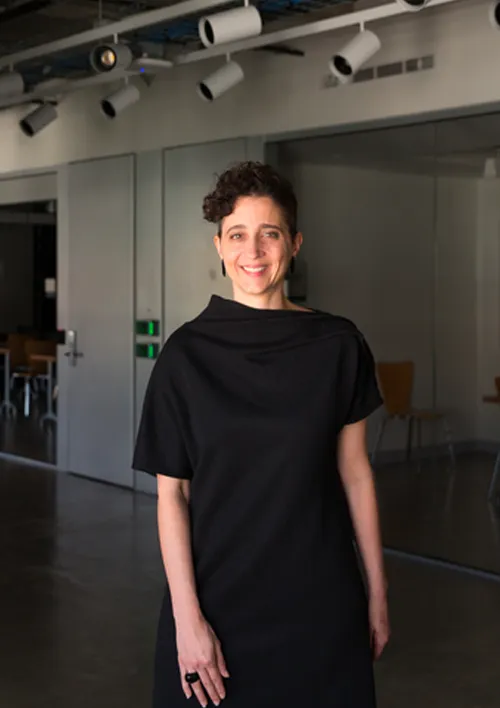
When you adopt an empathetic approach that puts people at the center, you can apply it to any area of design.
Prior to joining the School of Design and Creative Technologies as the M.A. in Design Program Director, Tamie Glass was a tenured faculty member and program director in the University of Texas School of Architecture. Her intercontinental career launched at Daimler in Germany with the creation of corporate identity projects for the Mercedes-Benz brand and followed by several years of experience in London for top firms Virgile & Stone and Conran and Partners. Tamie's teaching and research focus on designing for human behavior. Her book, Prompt: Socially Engaging Objects and Environments, was awarded the Interior Design Educators Council's book of the year for 2020. In addition to teaching and practice, Tamie served as a visiting director at the Design Institute for Health and the Blanton Museum of Art.
Beyond her leadership, Tamie is guiding the inaugural cohort for the M.A. in Design focused on Design in Health in her courses, Designing for Human Behavior this fall and Design Futures in the spring. She made time to discuss her thoughts on design, joy and food. Read more below.
Q: What does design mean to you?
TG: I find that design can be challenging to describe—it can mean so many things depending on who you ask. For me, Herbert Simon's description really resonates. As an early design thinker, he stated: "Everyone designs who devises courses of action aimed at changing existing situations into preferred ones."
I appreciate how this frames design as an accessible activity that anyone can engage in.
Q: How does design show up in our daily lives?
TG: Expanding on the first question, I believe we are all continually attempting to change existing situations (whatever those might be in each of our lives) into preferred ones. This shows up in multiple ways, including all of the hacks and tweaks we make to improve upon something—whether that be a simple challenge we are trying to overcome or a complex problem we are chipping away at over time.
Q: How has your career path led you here to this role?
TG: In my education, then in practice, and now in teaching, I gravitate toward a project's human aspects. I realized very early that I tended to design for the human experience first and then moved onto the form and other elements. I have learned that when you adopt an empathetic approach that puts people at the center, you can apply it to any area of design. I believe this explains what drew me to my new role in the School of Design and Creative Technologies.
Q: Coming from architecture, how do you see the roles of design and health care coming together?
TG: Health care is overwhelmed with problems, and no one discipline can address its issues from within a silo. So while my area of expertise is in architecture and the creation of spaces, I value the interdisciplinary and transdisciplinary nature of design at large. I am inspired by the question: How might we use a designer's mindset and deep expertise in different areas to collaborate in ways that genuinely impact human health and wellbeing in positive ways?
Q: How are you pivoting your class offerings during COVID? What are the challenges and benefits to this experience?
TG: We're all a little more real and share our humanness in ways we didn't before. I believe this makes my course, Designing for Human Behavior, perhaps even more relevant. Our discussions around social connection, mental wellness, and physical health are top of mind. Also, we have experienced how quickly and how dramatically society can shift overnight. Becoming well-versed in imagining possible futures is increasingly more critical. This reality led me to add a Design Futures course to the health-focused M.A. in design program that I had the honor of co-teaching with futurist Jake Dunagan.
Q: What’s bringing you joy lately?
TG: Cheryl Miller's enthusiasm. I have never been happier to see the color Goldenrod, now that I know more about its usage and roots in BIPOC culture.
Q: If you had to eat one meal every day for the rest of your life what would it be?
TG: Tacos, definitely, tacos.
Q: What’s the last book you read?
TG: I am always jumping from one book to the next, reading and re-reading. I currently keep pulling The Power of Moments: Why Certain Experiences Have Extraordinary Impact off my bookshelf.
By the way, I am often asked what books I recommend that relate to designing spaces for people. Here are 5 of my favorites, in addition to Prompt, of course!
-
Places of the Heart: The Psychogeography of Everyday Life by Collin Ellard
-
Snoop: What Your Stuff Says About You by Sam Gosling
-
Dunk Tank Pink: And Other Unexpected Forces That Shape How We Think, Feel, and Behave by Adam Alter
-
The Great Indoors: The Surprising Science of How Buildings Shape Our Behavior, Health, and Happiness by Emily Anthes
-
Welcome to Your World: How the Built Environment Shapes Our Lives by Sarah Goldhagen
Q: What’s your most used emoji?
TG: These days it is a lot about showing gratitude! ??

